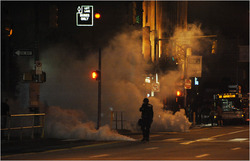Protesters Dispersed After G-20 Meeting
The police here arrested 110 people on Friday night, according to the mayor’s office. They dispersed hundreds of students milling near the University of Pittsburgh with pepper spray and smoke canisters in a scene reminiscent of the previous night’s disturbances on the first day of the economic summit.
The group, estimated at close to 500 people, gathered near Schenley Plaza around 10 p.m., with students saying they were drawn because they were angry over how the riot police treated students at Thursday’s gathering. Some students said their curiosity was piqued by a university message warning them to stay off the streets.

The police used a loudspeaker to announce that the plaza assembly was unlawful and ordered the crowd to disperse about 11 p.m. Soon afterwards, plumes of white smoke could be seen rising near Bigelow Boulevard and officers beating cadence on plastic shields with long batons marched down Forbes Avenue, driving back students, onlookers and journalists. A block north, as people scattered, officers fired projectiles at a young man riding a scooter down Fifth Avenue, knocking him to the ground and arresting him.
It was the second consecutive night of turbulence in the bustling streets surrounding the university, where crowds of bar-hoppers were largely displaced by fleets of police vans, armored vehicles and phalanxes of officers wearing helmets, padded vests and shiny plastic shin guards.
On Friday morning a flier had circulated instructing people to gather again at the university to protest Thursday night’s events. The police then had rushed towards students in a dormitory courtyard and squirted pepper spray after black clad protesters dashed though nearby streets, smashing the windows of a University of Pittsburgh police sub station and several restaurants. Those protestors had also ignited a dumpster, which they rolled into the intersection of Forbes Avenue and Oakland Avenue before fleeing into the university campus.
Dillon Snyder, 18, a freshman at the university, said he was retreating from clouds of white smoke on Thursday, when he was struck above his right elbow with a kind of projectile fired by police.
On Saturday, he said his elbow was still sore, as he reflected on the events on his campus over the past two nights.
“There was really no reason for such extreme action,” he said. “The guns, the rubber bullets and the dogs probably did more to incite people.”
The nighttime disturbances around the university was in stark contrast to the peaceful and permitted march in downtown Pittsburgh on Friday
There, protesters with Iraq Veterans Against the War, wearing fatigues, marched alongside Tibetans chiming cymbals, chanting denunciations of China and waving signs, like one that read “G20 Let’s Talk Tibet.” Students for Justice in Palestine assembled on Forbes Avenue and called for an end to “the Israeli occupation.” Others held up signs like “We Say No To Corporate Greed,” and “We say yes to human needs.”
One group held aloft with bamboo poles a giant fabric replica of a dove. A marching band with a French horn, several snare drums and a trombone played amid a sea of black, American and Palestinian flags.
The People’s March, as it was called, was sponsored by the Thomas Merton Center, a Pittsburgh peace organization. It came a day after the first raucous confrontations between the police and protesters resulted in 66 arrests. At least five people needed medical attention, and about 19 businesses sustained damage.
Observers put the crowd at Friday’s march at 3,000 to 4,000. Speakers urged demonstrators to fight for an array of social issues they felt had been largely ignored in global economic policy.
“We need to show the world that G-20 is not welcome in Pittsburgh,” Pete Shell, the director of the Merton center’s antiwar committee, said from the steps of the city-county building, just blocks from the David L. Lawrence Convention Center, where the G-20 meeting was under way.
It was as close as the protesters were able to get to the meeting of world leaders.
“The city has rolled out the red carpet for them,” Mr. Shell said. “But we need to show them that you are the ones we welcome.”
Nathan Smith, 31, a wine seller from Williamsport, Pa., said he drove three hours to attend the rally. “We need good jobs and good health care, and the G-20 isn’t helping that,” said Mr. Smith, who was carrying a sign that said “Capitalism Kills.” “Their policies are undermining jobs and health care.”
A member of the local chapter of Code Pink, a women’s antiwar group, led a protest against the continued presence of American troops in Afghanistan.
Rows of police officers looked on from the sidewalk, watching a group of more than 400 self-described anarchists clad in black.
Before long, singers from the Raging Grannies and workers from the United Steelworkers of America took the stage to talk about the need for jobs.
After more than an hour, the crowd began to disperse, some wondering aloud if the G-20 leaders would hear their messages.
Cory Perrotte, 20, a student from Duquesne University, was optimistic that it would be hard to ignore thousands in the street.
“They will listen to a certain degree,” he said. “They might not necessarily do anything.”
Ian Urbina and Sean D. Hamill contributed reporting from Pittsburgh.
Source: http://www.nytimes.com/2009/09/27/world/27protest.html?_r=1&hpw



